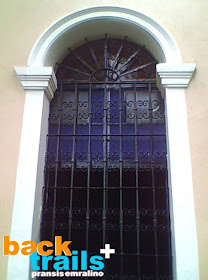 * a side entrance to the church premises
* a side entrance to the church premises * the huge buttresses of the church and a cross design on one of the side doors
* the huge buttresses of the church and a cross design on one of the side doors * one of the tall windows that deck the walls of the church
* one of the tall windows that deck the walls of the church * a statue of St. John the Evangelist: patron of authors, burns, poisoning, theologians, publishers, booksellers, editors, friendships, and painters; found just outside the main entrance
* a statue of St. John the Evangelist: patron of authors, burns, poisoning, theologians, publishers, booksellers, editors, friendships, and painters; found just outside the main entranceJust like in other towns in the Philippines, the Church of Ibaan is found at the heart of the town, easily accessible to visitors and townsfolk alike. However, the present church that can be seen in the town was once a simple chapel built in the present-day Barangay of Matala in 1784. Sometime between 1784 and 1800, a convent was made, although the information I obtained was not clear; it was not specified if the convent was annexed to the chapel or was erected as a separate structure. In any case, a fire that raged in 1801 destroyed the convent.
 * a close-up of one of the carving designs of the main door
* a close-up of one of the carving designs of the main door * St. James wielding his sword while riding his comical horse
* St. James wielding his sword while riding his comical horse * one of the saint’s apparent enemies sprawled on the ground
* one of the saint’s apparent enemies sprawled on the groundThree years later (1804) Ibaan was organized into a town and later had its first church in 1817. Administration of the church was handled by Rev. Grijalbo, O.S.A. followed by the Bishop of Nueva Caceres [of Naga?]. The church that one can see in Ibaan (exempting perhaps some minor reconstructions within and without) was first constructed under the supervision of Manuel Diez Gonzales O.S.A. in 1854. Rev. Bruno Laredo O.S.A. oversaw its completion in 1869, a construction that spanned more than ten years. One cannot help but wonder – again – if forced labor was used for the creation of this place of worship. Later additions were done such as the [church] towers and the façade in 1876 supervised by Rev. Vicente Maril O.S.A.
 * the baptistery
* the baptistery * some of the items inside the baptistery
* some of the items inside the baptistery * this shot gives you an idea of the size of the church
* this shot gives you an idea of the size of the church * a closer look at the church’s retablo
* a closer look at the church’s retablo * a ‘golden’ pulpit
* a ‘golden’ pulpit I understand if the design, or technically the architecture, of the churches built during the Spanish period were derived from architecture influences of those who supervised their construction. Or perhaps simply because of personal preference. But the ‘overworked’ symmetry of the façade seems to me quite an eyesore. I don’t know but I just don’t like staring at it for a long time. But one of course, especially a chance reader, should not take that opinion as their own. For it would severely create a bias, and perhaps discouragement, to see what lies inside the church.
Again, as I have said many times in our tours, it is a treasure place.
In the interior, one can see a profusion of images that depict St. James the Greater defeating what looked like his enemies. (As of this writing, I still have not read any text or information about this particular saint.) The baptistery, on the other hand, contains an interesting set of religious items and images that evoke an atmosphere of solemnity inside the room.
As for the church’s altar, it was noted that it was originally made of wood. This was renovated and refurnished using chestnut marble and blessed on March 5, 1972. The renovation was made possible by the pledges by Ibaanenses, as they call themselves, living there or working abroad.






No comments:
Post a Comment